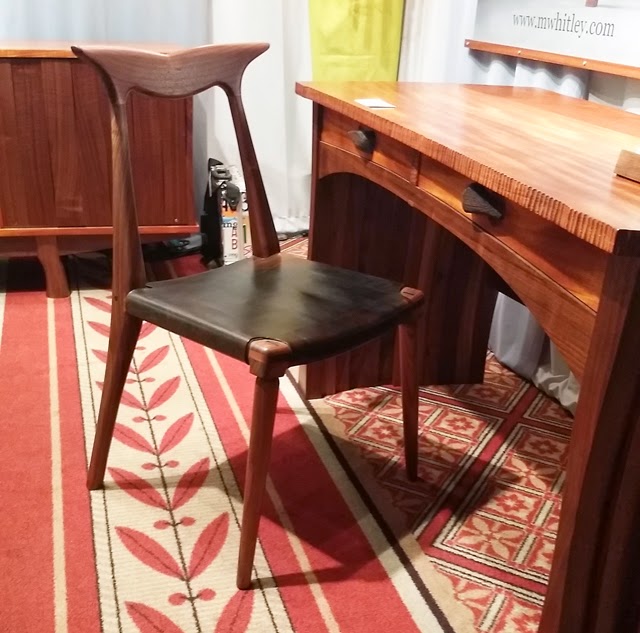I think when most people hear the words “craft show” they think about rag dolls, bird houses and homemade fudge as a marching band fundraiser at the local high school. But there is an entirely different side to craft. Even if you’re familiar with the world of indie craft via Etsy or shows like Crafty Bastards, you’ll be astonished by the quality of work at a fine craft show like the Smithsonian Craft Show held annually at the National Building Museum. Warning: this is a long, photo-heavy post.
The show is organized and run by the Smithsonian Women’s Committee and benefits Smithsonian grant programs that fund research, special exhibitions and other programs that would not be possible without independent funding. Wednesday night I attended the opening night preview party, though to be honest I was much too distracted by my conversations with the artists to do much partying. I think I managed one glass of wine all night and that was about it.
I’ve attended this show for several years and I’m always impressed by the level of skill exhibited, but this year’s crop of artists really blew me away. It seems every artist I spoke to had a truly unique or exceptional skill to bring to their craft.
Take this chair by Mark Whitley. Be forewarned: I have a major thing for chairs, which I think are absolutely the hardest thing for a woodworker to design and build. Think about it. It has to be lovely to look at it; it has to be comfortable; it has to be sturdy and not fall apart; chairs are moved around a lot, bumped against walls and generally mishandled in a way that casegoods usually aren’t. And I loved this chair so much that I could do a whole post on it. Really. All the hearts for this chair.
One of the things that is great about craft shows is that you can ask the makers why they made the choices they did with regard to style or construction. Whether you’re a collector of contemporary studio furniture, vintage furniture or just a lover of well-made things, seeing joinery like this is a real education. Knowing something about how wood furniture is made gives me a huge advantage when it comes to spotting treasures in thrift stores: for example, what a hand-cut dovetail looks like versus one that is machine cut. I know where to check joints to be sure they’re sound or fixable before snapping up that vintage steal. And looking at books is absolutely no substitute for talking with a woodworker who really knows his stuff because on a really good piece of furniture, what’s going on inside is just as interesting as what’s going on outside.
The first thing I noticed about this chair is that it looked like the front legs might be turned, which is a totally different process than the shaping done on the back legs, requiring the mastery of an entirely distinct set of skills: using a lathe that spins instead of various types of stationary tools to shape a part. Chatting with Mark confirmed that the front legs are indeed turned by him. A lot of the time craftsmen will just buy those kinds of parts because the skills and tools are so different.
Upon further discussion, it seems that not only is the tenon on that front leg wedged, he bakes that piece to lower the moisture from the typical 8% that he usually works with. It shrinks the part so that when he pounds it into place and it expands over the next few days, just reabsorbing moisture from the air, it tightens up the joint even more. The only way that leg is going anywhere is if you take a saw to it.
The next thing I noticed is that the top rail looked very precarious up there. That’s a pretty tiny spot for just a bit of glue to be holding that. However, inside this joint is a half-inch thick, three inch long dowel. That’s a lot of structure. It took me from worrying about the long-term viability of this joint to utterly secure in its longevity. Okay, rather than go on and on (I know, too late), just go see this chair for yourself and talk to Mark about it. Though I did upload a few more full-size photos to an album for those or you who are seriously into joinery.
One of the aspects of this year’s show that stuck out was the humor and lightheartedness of a lot of the work. The ceramic mugs above are by Beer Chunhaswasdikul. He has been in the show before, which I know because we own several of his pieces–both the grenade mugs pictured above and a different design that incorporates a ceramic whistle. Even though the glaze is somewhat metallic, these mugs can go in the microwave. You just have to pull the pin first. How utterly morbidly humorous!
Next is this ceramic teapot by Gerard Justin Ferrari. Yes, I said ceramic teapot. Not metal. And okay, so it’s shaped like a toy airplane and both the wheels and the propeller actually turn. In fact, that hole up there at the top turns to reveal the spot where you’d put water in for tea.
I’m apparently really digging the trompe-l’oeil teapots because here’s another ceramic teapot from Eric Serritella. I took this photo from several feet away, but even from just a few inches, you would not believe that this teapot isn’t wood. Eric had a demonstration piece available for handling and aside from it being just a bit too heavy to be birch wood, even the texture was convincing.
Contemporary wood furniture might seem an odd thing to talk about in terms of humor, but that’s just what struck me about the work of Michael Gloor. He started out many years ago as a ceramic artist before moving to working in wood, which gives his pieces a sculptural quality.
But what I want to highlight here is his use of colored epoxy. The center strip of this dining table is maple and the edges are cherry with mineral deposits (those black dots). Often, the mineral deposits can create little divots as you slice the wood to use for furniture. It’s generally not considered to be desirable and most furniture designers would not select a board that had that “defect”. But Gloor instead chooses to highlight it by filling the holes with epoxy that matches the maple strip in the center. Maybe you have to be a furniture nerd to see the humor in that, but once I figured out what was going on there, I was most amused.
No matter the medium, what really stands out at this show is the phenomenal, almost miraculous technique of these artists. Carrie Gustafson makes these stunning blown glass vases and bowls. She first creates the layers of glass and then applies hand cut stencils to the surface before carefully sandblasting away the top layer to create the luminous final piece. Just a few seconds too long and the process punches right through the glass.
Another artist with astonishing technique is Lucrezia Bieler. She creates hand cut paper art that to the untrained eye probably looks like a print of some sort. It isn’t.
She uses tiny scissors to create both negative and positive space, revealing an image. See above how the thorns are “dark” and the flowers are “light”? I was floored by both the design and execution of these works. They are just so incredibly detailed. One of the larger works on display this weekend took her six months to complete.
Speaking of ultra-detailed work that takes immense amounts of patience and time, Martha Fieber creates photo-realistic landscapes in thread. When I first passed her booth, they really looked like photographs. Each piece has many layers of thread that create the picture with a sense of dimension and perspective. They’re also incredibly pretty.
While I will always have a fondness for fine art, which formed the basis for my art history education, my love of decorative arts is really what drives both my collecting and my shop. Handling everyday things that are lovely to look at, a pleasure to touch and functional to use pretty much forms the basis of my fascination for art and design. There are always stunning examples of this at the Smithsonian show and this year is no different.
Borealis Studios is comprised of Devin Burgess Glass and Jerilyn Virden Ceramics. Even in the terrible light of the National Building Museum toward the end of the evening, Burgess’s glass is radiant. It reminded me most of the Aseda vase I had in the shop just a while ago in terms of the depth of color. And Virden’s ceramics are the perfect complement, grounding the ethereal glass with practical earthenware in black and white. It’s difficult in ceramics to create such simple work that doesn’t remind me of anything else. I was particularly covetous of the serving pieces and when I’m in “blog mode” it’s extremely tough to get me to look at objects in terms of actual purchasing.
The work of Eshelman Pottery does refer back to the best mid century ceramics before taking off in a more contemporary direction. These are simple, utilitarian pieces that can go in the microwave, dishwasher and oven. I see both a little bit of Dansk and a little bit of Heath Ceramics in this casserole, for example.
But then you get these little ergonomic bowls, which are utterly their own thing. There’s a photo on the Eshelman website of hands wrapped around that bowl with a thumb tucked into the hole at the top. After the winter we had, I can clearly see the appeal. I predictably love anything with both glazed and unglazed surfaces so it’s not surprising that I could see outfitting my entire kitchen with these pieces.
Even though I’ve shared some of my favorite pieces here, this stuff really is best viewed in person. Like this wood clock made by James Borden of Timeshapes. It was a little noisy while I was filming, but in person I barely noticed it because I was mesmerized. There is something extremely elegant and soothing about watching this clock in action. These are the sorts of works that will be in the Renwick Gallery in years to come and getting a chance to meet and talk with the artists is a real privilege.
The Smithsonian Craft Show runs today through Sunday at the National Building Museum. Admission is $15 and I wouldn’t devote less than 3 hours.



















